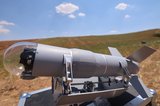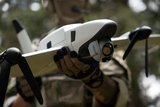Global Hawk flies record mission hours
According to a 7 January release by Northrop Grumman, its US Air Force RQ-4 Global Hawk and other High Altitude Long Endurance (HALE) Unmanned Aircraft System (UAS) series variants have flown more ISR missions than even before in one week.
From 10 to 16 September, The UAS series flew 781 hours, of which the RQ-4 Global Hawk flew 87%. The rest were flown by the navy's Broad Area Maritime Surveillance- Demonstration (BAMS-D) aircraft and NASA's Global Hawk hurricane research asset.
The company had previously achieved a weekly flight record of 665 hours in February. Within a week of accomplishing its record, two new RQ-4 Global Hawks were delivered to the air force: a wide area surveillance model on 10 September and a multi-INT model on 3 October.
With this increase in fleet size and flight hours, combatant commanders will get more ISR capabilities at a time when demand is often higher than aircraft availability. The new models bring the fleet size to 33. An agreement for three more units was signed in August, and they are scheduled for delivery in 2016 and 2017.
Mick Jaggers, Global Hawk UAS program director, Northrop Grumman Aerospace Systems, said: 'There are at least two Global Hawks in the air at all times providing indispensable ISR information to those that need it.'
He added: 'The 2014 fiscal year was the most active yet for the Global Hawk, with a 40% year over year increase in flight hours.
Related Equipment in Defence Insight
More from Uncrewed Vehicles
-
![What's next for the Pentagon after the Replicator programme?]()
What's next for the Pentagon after the Replicator programme?
Although the Replicator initiative has made several accomplishments, there are still multiple gaps to plug across the US Department of Defense (DoD) and its services.
-
![Cummings Aerospace showcases Hellhound loitering munition designed for US Army’s LASSO programme (video)]()
Cummings Aerospace showcases Hellhound loitering munition designed for US Army’s LASSO programme (video)
Cummings Aerospace presented its turbojet-powered Hellhound loitering munition at SOF Week 2025, offering a man-portable solution aligned with the US Army’s LASSO requirements.
-
![SOF Week 2025: PDW unveils attritable FPV drone for SOF operations at scale]()
SOF Week 2025: PDW unveils attritable FPV drone for SOF operations at scale
PDW has revealed its Attritable Multirotor First Person View drone at SOF Week 2025, offering special operations forces a low-cost, rapidly deployable platform for strike and ISR missions, inspired by battlefield lessons from Ukraine.
-
![SOF Week 2025: Teledyne FLIR white paper provides guidance on reusable loitering munitions]()
SOF Week 2025: Teledyne FLIR white paper provides guidance on reusable loitering munitions
Teledyne FLIR is highlighting the emerging requirements for 'recoverable and re-usable' loitering munitions across the contemporary operating environment during this week’s SOF Week conference in Tampa, Florida.
-
![SOF Week 2025: Kraken Technology group debuts K3 Scout USV in North America]()
SOF Week 2025: Kraken Technology group debuts K3 Scout USV in North America
High-performance maritime industry player Kraken Technology Group, based in the UK, has used the SOF Week conference in Tampa, Florida this week to debut its K3 Scout uncrewed surface vessel (USV) to the North American market.
-
![Palladyne AI and Red Cat to demonstrate capabilities for autonomous drone swarms to the US military]()
Palladyne AI and Red Cat to demonstrate capabilities for autonomous drone swarms to the US military
Red Cat and Palladyne AI recently conducted a cross-platform collaborative flight involving three diverse heterogeneous drones.

























